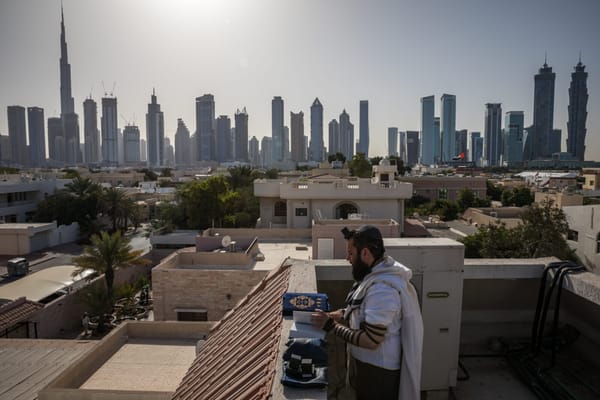After two months out of the media spotlight, the war-ravaged country of Somalia is once again the subject of speculation about the next theater of George W. Bush's "war on terrorism." In comments to the Senate Armed Services Committee on March 19, CIA director George Tenet named Somalia as an "environment [where] groups sympathetic to al-Qaeda have offered terrorists an operational base and potential haven." Two days later, the Pentagon sheepishly retracted an earlier statement that a handheld Global Positioning System device found by US Special Forces combing caves in eastern Afghanistan had belonged to an American soldier killed in the 1993 Mogadishu firefight depicted in the Hollywood film "Black Hawk Down." Though the press first reported this discovery as a link between Somalia and al-Qaeda, subsequent investigations revealed that a different soldier had lost the device in the heat of Operation Anaconda in early March.
Less widely reported was the recent four-day visit to the Horn of Africa by Gen. Tommy Franks. Franks heads the US military's Central Command, which runs the war in Afghanistan and is responsible for the Middle East, Central Asia and the Horn of Africa—the region made up of Eritrea, Ethiopia, Sudan, Djibouti and Somalia. Together with Kenya, these states are joined in a regional organization called the Intergovernmental Authority for Development (IGAD). These same states—minus Somalia—were characterized by Franks in a BBC interview as "front-line nations" in the buildup for a possible US intervention in Somalia. US ships are now patrolling the Red Sea. German reconnaissance planes fly over the Somali coastline for ten hours each day. Ground fact-finding teams have also traveled in and out of Somalia in recent weeks. The US may be laying plans for a major operation, though likely not on the scale of the intervention in Afghanistan.
Troubled History
Most Americans associate Somalia with the "humanitarian intervention" in 1992-1993 that climaxed with the deaths of 18 US Army Rangers during an abortive attempt to arrest Somali warlord Mohammed Farah Aideed. These are the events heavily fictionalized in "Black Hawk Down." But US involvement in Somali affairs has a longer and more troubled history.
The first US client state in sub-Saharan Africa was Ethiopia, whose armed forces served in US-led missions in Korea and the Congo in the 1950s and 1960s. For nearly a quarter-century, more than half of all US aid to Africa went to Ethiopia, which gave the US basing rights in the newly annexed territory of Eritrea in exchange. But soon fierce contention between the two superpowers across the region produced some of the most bizarre and cynical geopolitical maneuvers of the era.
Coups d'etat in 1969 brought pro-Soviet military regimes to power in Somalia and Sudan, under Siad Barre and Jaafar Nimeiri, respectively. In response, the US moved to further strengthen ties with Ethiopia, as that country slid deeper and deeper into a brutal counterinsurgency war in Eritrea, where a national liberation movement was challenging its claims on the territory. To support the war effort, Washington sent Ethiopia the first supersonic fighter aircraft to appear on the continent, along with Green Berets to train Ethiopian troops in the latest anti-guerrilla techniques. Israel also provided military aid and training.
In 1974 a coup in Ethiopia brought the military to power, but the US remained deeply involved. The National Security Agency maintained one of the largest overseas spy bases in the world in Eritrea. A large Soviet naval base dominated the Somali port of Berbera.
Then, in 1977, the superpowers traded places. Ethiopia ousted the US and invited the Soviets to come in. When the USSR accepted the offer, Somalia, then at war with Ethiopia over its disputed southeastern Ogaden region, kicked the Soviets out of Mogadishu and invited the US to take their place. Meanwhile, with the USSR in disfavor in Khartoum for backing an abortive Communist Party-led coup, Nimeiri welcomed the US to Sudan. The US also built up its military and diplomatic presence in Kenya and on the Indian Ocean atoll of Diego Garcia as part of a broad strategy of encirclement targeted at the Soviet posture in Ethiopia. Over the next decade, the USSR poured more than $10 billion in arms into Ethiopia, while the US dumped billions more into Sudan and Somalia. These weapons and the wars they fueled were a major cause of the horrific famine in the mid-1980s, and they still drive the local conflicts in the region today.
Disintegrated State
The end of the Cold War presaged the virtual disintegration of Somalia as a functioning state in 1991. The country's ethnic and religious homogeneity did not prove sufficient to hold it together once the superpowers pulled back and the Siad Barre regime collapsed under the weight of economic disaster and multiple military and political challenges from clan-based warlords. Somalia faced the onset of severe famine in 1992, a condition that led to a US-UN "humanitarian intervention" that year and to the Black Hawk debacle in 1993. The country remains desperately poor, more so after the Bush administration's closure of the al-Barakat money transfer offices by which Somali emigrants send cash home to relatives. International distrust of the group of Somalis calling itself the Transitional National Government (TNG) means that about 80 percent of the UN's $30 million request for Somalia remained unfunded by member governments in 2001.
Today, there are two mini-states—Somaliland and Puntland—in the northern portion of Somalia, once under the colonial rule of Britain. Most of the east and south, once Italian Somaliland, is ungoverned by any central authority. This part of Somalia is most open to Islamist penetration, and much of it has for years been under the influence, if not the actual rule, of a group known as al-Ittihad al-Islamiyya (Islamic Unity) that was tied to Osama bin Laden's network in the 1990s. However, in the latter half of the decade, Ittihad was repeatedly attacked by Ethiopia, whose forces drove deep into Somalia several times, and its power and influence are declining today, Ethiopian claims to the contrary. While Franks was in Addis Ababa, Ethiopian Prime Minister Meles Zenawi told reporters that Ittihad members had infiltrated the 245-person legislature of the TNG, as well as the fledgling national army.
Somalia and Ethiopia
The TNG was set up at a conference in Djibouti in 2000 with the support of all IGAD states but one, Ethiopia, which has a large ethnic Somali minority. Comprised of Somali elders, businessmen, military officers, representatives of civil society and some warlords, the TNG is the only nation-building effort currently underway in the country. Its new army, made up of 90 women and 2,010 men, was equipped March 21 with guns and armed wagons surrendered to the TNG by private parties in exchange for money, according to TNG officials. TNG president Abdulkassim Salat Hassan instructed the recruits to use the weaponry to "pacify Mogadishu and other parts of Somalia by fighting bandits, anarchists and all forces that operate for survival outside the law." But the TNG holds sway over only one sector of the Somali capital; rival warlords control the rest of the country.
One rival, Musa Sudi Yalahow, accused Libya of sending the arms to battle any US troops who might eventually land in Somalia, an accusation hotly denied by the TNG. Yalahow belongs to the loose Ethiopian-backed grouping known as the Somali Restoration and Reconciliation Council (SRRC). The TNG says that Ethiopian troops train Somali militiamen in the SRRC stronghold of Baidoa in the south of the country. Ethiopia also shelters the leader of the SRRC, Hussein Mohammed Aideed, the son of Mohammed Farah Aideed, who has denounced the equipment of soldiers by the TNG as a violation of the UN arms embargo imposed in 1992. The SRRC nearly splintered in the second week of March, and has little holding it together today beyond Ethiopian support. Factional fighting reportedly continues to rage in Mogadishu.
Ticking War Clock
US policy in sub-Saharan Africa is built around the concept of "anchor states." These states are the main focus of US aid and diplomacy and serve as hubs through which the US seeks to influence events in surrounding sub-regions. Three countries carry this designation today: South Africa, Nigeria and Kenya. Ethiopia long occupied a similar place in the pantheon of US allies and clients in Africa—except during the Soviet period—and it is now apparently slouching back into an "anchor" position. Since September 11, the main thrust of US initiatives in the Horn of Africa has been to strengthen relations with Ethiopia, stepping up military cooperation with Addis Ababa despite its unresolved conflict with neighboring Eritrea. At the same time, the US is exploring the possibility of a thaw in relations with Sudan and assessing entry points for a direct intervention in Somalia. The Washington Post reported March 22 that the State Department was convening an inter-agency meeting to evaluate US-Ethiopian suspicions of Ittihad infiltration into the ranks of the TNG, which the Bush administration does not recognize.
If the US were to move to strengthen the TNG's capacity to police its own territory and to reassemble the country, while restraining Ethiopia from intervening in Somalia's internal affairs, such action might be a significant contribution to stability and development in the Horn of Africa. But the war clock in Washington appears to be ticking ever faster, foreclosing the possibility of such constructive engagement. If US ships and German overflights are indeed gathering intelligence for Washington planners of military action in Somalia, the questions are: when, under whose auspices, at what level, for how long and with what specific objectives?
Written by









